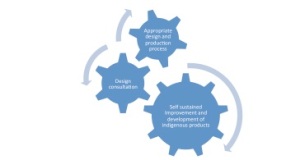PROJECT 1: Design Literacy in Indigenous Product Communities (OTOP)
Economic Context
Thailand has faced both an upturn and downturn in economy, and is now progressing toward a more sustaining development. Realizing that the economy also relies on stable political condition, both public as well as private sectors strive to establish economic strategies that would help sustain the economy despite political instability. One of the strategies included in the 11th Economic and Social Development Plan is to direct Thailand towards creative economy. The objective is to establish a creative economy that integrates existing cultural heritage, creativity, and mass manufacturing technology in order to create a new source of income for the country. This has geared most policies directly towards more emphasis on creative education especially on product design due to its most tangible success on the milieu of mass manufacturing and profitability. However, in order to accomplish the aforementioned success, product designing in Thailand needs to be more anchored in actual market conditions especially in product design literacy, mass manufacturing technology and environmental policy.
Rationale
The awareness and understanding of the importance of safe, functional, and attractive products in improving the quality of life can also be defined as product design literacy. In order to explore the notion of product design literacy, the department has initiated the project ‘Product Design Literacy in Thai Indigenous-based Product Communities’. The aim of the project is to establish a discourse with real needs and problems faced by indigenous-based product communities. Particular interest of this project is indigenous product design culture of small local community producers and manufacturers such as in OTOP projects. As the success of OTOP products depend mostly on local wisdoms and skills as well as how to propel the products into the market, it is important to gain insight into the product development process in order to employ appropriate strategies, which will also ensure the authenticity of the products as well as market volatility.
Objectives
- To gain insightful understanding of indigenous product design processes of the community.
- To identify needs and problems faced by indigenous craftsmen and producers.
- To initiate the discourse in product design literacy in the community.
- To formulate possible design and production solutions for the product.
Methodology
The project adopts community-based action research as a method to gain understanding and insights into the condition of indigenous product design culture in Thailand. The method as deliberated by Stringer (1996) involves:
Phase I
The result of the design literacy discourse with the community is then used as a basis for formulation of design solution and production process appropriate to the indigenous product. In the second phase of the project, the solutions are presented to the community and the research participants conduct a follow up product test to evaluate the effectiveness of the design solution and production process. The results are then used to improve the product.
Phase II
Phase III
In the final phase of the project, research participants formulate design and production process appropriate to the product in retaining authenticity and market viability. Working connection with the community in the form of consultation is also established. This is to assist the community in future self-sustained development and improvement of the indigenous products.
PROJECT 2: Kradee Jean Art on the Street 5
PROJECT 3: Products for the Blind



